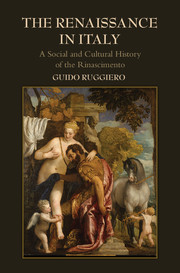Book contents
- Frontmatter
- Dedication
- Contents
- List of Illustrations
- Acknowledgments
- Maps
- Introduction: The End of the World and Its Rebirth (Rinascita) as the Rinascimento
- 1 Legitimacy: A Crisis and a Promise (c. 1250–c. 1340)
- 2 Civiltà: Living and Thinking the City (c. 1300–c. 1375)
- 3 Plague: Death, Disaster, and the Rinascita of Civiltà (c. 1325–c. 1425)
- 4 Violence: Social Conflict and the Italian Hundred Years’ War (c. 1350–1454)
- 5 Imagination: The Shared Primary Culture of the Early Rinascimento (c. 1350–c. 1475)
- 6 Courts: Princes, Aristocrats, and Quiet Glory (c. 1425–c. 1500)
- 7 Self: The Individual as a Work of Art (c. 1425–c. 1525)
- 8 Discovery: Finding the Old in the New (c. 1450–c. 1560)
- 9 Re-Dreams: Virtù, Saving the Rinascimento, and the Satyr in the Garden (c. 1500–c. 1560)
- 10 Reform: Spiritual Enthusiasms, Discipline, and a Church Militant (c. 1500–c. 1575)
- 11 Retreat: The Great Social Divide and the End of the Rinascimento (c. 1525–c. 1575)
- Epilogue: The Diaspora of the Rinascimento
- Bibliography: A Short List of Works Used
- Index
6 - Courts: Princes, Aristocrats, and Quiet Glory (c. 1425–c. 1500)
Published online by Cambridge University Press: 05 December 2014
- Frontmatter
- Dedication
- Contents
- List of Illustrations
- Acknowledgments
- Maps
- Introduction: The End of the World and Its Rebirth (Rinascita) as the Rinascimento
- 1 Legitimacy: A Crisis and a Promise (c. 1250–c. 1340)
- 2 Civiltà: Living and Thinking the City (c. 1300–c. 1375)
- 3 Plague: Death, Disaster, and the Rinascita of Civiltà (c. 1325–c. 1425)
- 4 Violence: Social Conflict and the Italian Hundred Years’ War (c. 1350–1454)
- 5 Imagination: The Shared Primary Culture of the Early Rinascimento (c. 1350–c. 1475)
- 6 Courts: Princes, Aristocrats, and Quiet Glory (c. 1425–c. 1500)
- 7 Self: The Individual as a Work of Art (c. 1425–c. 1525)
- 8 Discovery: Finding the Old in the New (c. 1450–c. 1560)
- 9 Re-Dreams: Virtù, Saving the Rinascimento, and the Satyr in the Garden (c. 1500–c. 1560)
- 10 Reform: Spiritual Enthusiasms, Discipline, and a Church Militant (c. 1500–c. 1575)
- 11 Retreat: The Great Social Divide and the End of the Rinascimento (c. 1525–c. 1575)
- Epilogue: The Diaspora of the Rinascimento
- Bibliography: A Short List of Works Used
- Index
Summary
A Great Turning Point Forgotten?
On July 6, 1439, the famed architect Filippo Brunelleschi’s (1377–1446) recently domed Cathedral of Santa Maria del Fiore, which dominated the cityscape of Florence and the imagination of many as the engineering and spiritual marvel of the day (Illustration 6.1), was the setting for an earthshaking proclamation. Under the remarkable free-standing dome referred to as Il Duomo (the Dome), along with the relatively new leader of Florence, Cosimo de’ Medici (1389–1464; “in power” 1434–1464), in attendance for the historic moment were the Greek emperor John VIII Palaeologus (1390–1448; emperor 1425–1448); the Patriarch of Constantinople, Joseph II, arguably the most important leader of the Eastern or Orthodox Church; a host of eminent Greek churchmen; Pope Eugenius IV (1383–1447; a pope 1431–1447); numerous cardinals; a large group of leaders of the Western Church; and a sizeable contingent of local notables. With impressive festivities and pageantry they were regaled with the formal announcement that the Church Council originally convened in Ferrara in 1438 and now meeting in Florence had concluded an agreement to reunite the Eastern Orthodox with the Western Catholic Church, ending almost a millennium of discord that had divided Christianity.
It seemed to be a great turning point in history. Making the reunion of the two churches even more significant, and in many ways making it possible, was the hope that a unified Christianity would be able to face the menace of an expanding Turkish Empire in the east, which threatened the Eastern Roman Empire centered in Constantinople. A crusade, it was hoped, would stop Turkish expansion in the east and strengthen the Eastern Roman Emperors in the bosom of a now unified Christianity. And it was not by chance that this agreement was reached in Florence, for the newly completed architectural masterpiece of Florence’s great Duomo was not only a testament to Rinascimento spiritual enthusiasm, artistic leadership, and technological virtù, it was a very visible measure of that city’s wealth, power, and leadership in Italy and Europe, all of which were deeply intertwined with the great wealth and European reach of its new leader, Cosimo de’ Medici, who had come to power in Florence just five years earlier.
- Type
- Chapter
- Information
- The Renaissance in ItalyA Social and Cultural History of the Rinascimento, pp. 268 - 325Publisher: Cambridge University PressPrint publication year: 2014



